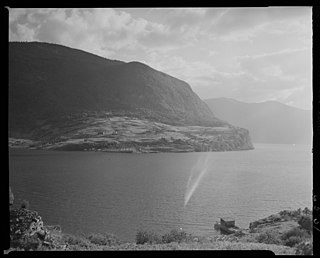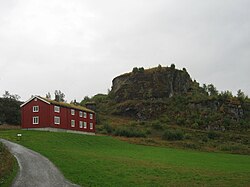
The Birkebein Party or Birkebeinar was the name for a rebellious party in Norway, formed in 1174 around the pretender to the Norwegian throne, Eystein Meyla. The name has its origins in propaganda from the established party that the rebels were so poor that they made their shoes of birch bark. Although originally a pejorative, the opposition adopted the Birkebeiner name for themselves, and continued using it after they came to power in 1184.

Sverre Sigurdsson was the king of Norway from 1184 to 1202.

Inge II was King of Norway from 1204 to 1217. His reign was within the later stages of the period known in Norwegian history as the age of civil wars. Inge was the king of the birkebeiner faction. The conclusion of the settlement of Kvitsøy with the bagler faction in 1208 led to peace for the last nine years of Inge’s reign, at the price of Inge and the birkebeiner recognising bagler rule over Viken.
Magnus V was a king of Norway during the civil war era in Norway. He was the first known Scandinavian monarch to be crowned in Scandinavia. He helped to establish primogeniture in royal succession in Norway. King Magnus was killed in the Battle of Fimreite in 1184 against the forces of Sverre Sigurdsson who became King of Norway.
Haakon III Sverresson was King of Norway from 1202 to 1204.
Guttorm Sigurdsson was the king of Norway from January to August 1204, during the Norwegian civil war era. As a grandson of King Sverre, he was proclaimed king by the Birkebeiner faction when he was just four years old. Although obviously not in control of the events surrounding him, Guttorm's accession to the throne under the effective regency of Haakon the Crazy led to renewed conflict between the Birkebeiner and the Bagler factions, the latter supported militarily by Valdemar II of Denmark.

The Bagli Party or Bagler was a faction or party during the Norwegian Civil Wars. The Bagler faction was made up principally of the Norwegian aristocracy, clergy and merchants.
Eystein Meyla was elected a rival king of Norway during the Norwegian Civil War period.
Jon Ingesson Kuvlung was a pretender to the Royal Crown during the civil war era in Norway. He was a rival of the reigning King Sverre of Norway.
Sigurd Magnusson was a Norwegian nobleman who campaigned against King Sverre of Norway during the Civil war era in Norway.
Philip Simonsson, also known as Philip of the Crozier-men, was a Norwegian aristocrat and from 1207 to 1217 was the Bagler party pretender to the throne of Norway during the civil war era in Norway.
Haakon the Crazy was a Norwegian jarl and Birkebeiner chieftain during the civil war era in Norway. Håkon Galen was born no later than the 1170s and died in 1214. His epithet "the crazy" or "the mad" can also be translated as frenzied, furious or frantic and probably refers to ferociousness in battle.
Erling Ormsson, known as Erling Skakke, was a Norwegian Jarl during the 12th century. He was the father of Magnus V, who reigned as King of Norway from 1161 to 1184.
Sverris saga is one of the Kings' sagas. Its subject is King Sverre Sigurdsson of Norway and it is the main source for this period of Norwegian history. As the foreword tells us, the saga in its final form consists of more than one part. Work first began in 1185 under the king’s direct supervision. It is not known when it was finished, but presumably it was well known when Snorri Sturluson began writing his Heimskringla in the 1220s since Snorri ends his account where Sverris saga begins. Thus the saga is contemporary or near-contemporary with the events it describes. The saga is obviously written by someone sympathetic to Sverre’s cause, but the strict demands of the genre ensure some degree of impartiality.

The Battle of Fimreite was a naval battle fought on June 15, 1184, between King Magnus Erlingsson and the Birkebeiner supported Sverre Sigurdsson. At this time in Norwegian history it was extremely common for there to be changes in leadership, and political coups were often conducted to establish a new ruler. This inevitably led to the naval battle between Sverre Sigurdsson and Magnus Erlingsson that resulted in Magnus being defeated and killed in the battle, and Sverre usurping the Norwegian throne. Similarly, this battle also had long-lasting effects on Norway as a whole. As stated previously, Norway was very volatile during this time, however, the result of this battle led to the installation of Sverre and a lasting effect on Norway's leadership. Sverre would go on to rule from 1184 to 1202, making him one of the longest standing sovereign kings in Norway's twelfth and thirteenth century. His leadership along with Norway's recent conversion to Christianity that spread the Administrative apparatus of the papacy would have long lasting effects on Norway's culture, economy, and society.

The civil war era in Norway began in 1130 and ended in 1240. During this time in Norwegian history, some two dozen rival kings and pretenders waged wars to claim the throne.

Sverresborg is a fortress and former castle situated in the Norwegian city of Bergen.

Kalvskinnet is a neighborhood in the city of Trondheim in Trøndelag county, Norway. It is situated southwest of the city centre in the borough of Midtbyen, bordering the river Nidelva in the south. The area is dominated by public offices, including such institutions as the Norwegian University of Science and Technology, Sør-Trøndelag University College, and Trondheim Science Museum. There is also some quite expensive housing located in this area, characterized by buildings from the last century.
The Battle of Florvåg was a naval battle that was fought on 3 April 1194 between King Sverre Sigurdsson, leader of the Birkebeiner party, and Sigurd Magnusson, the Eyjarskeggjar party pretender. Although there had been previous revolts during Sverre's reign following his usurpation of the throne in 1184, the revolt in support of Sigurd Magnusson became far more threatening than the attempts of previous pretenders. In a larger context, the battle was part of the century-long civil war era in Norway.

The Battle of Ilevollene on 27 May 1180 was a battle between king Sverre Sigurdsson and king Magnus Erlingsson taking place at Ila in modern day Trondheim. The battle ended up as a huge victory for king Sverre.












